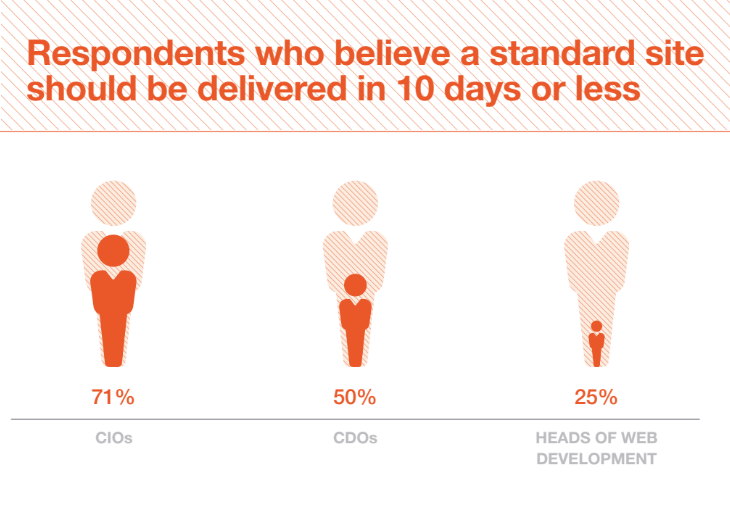Every senior professional in every industry has high expectations. Whether it’s for their teams around them or for the business as a whole, most people appreciate that no business makes progress without having high standards.
Having high expectations is certainly true when it comes to digital marketing. With so many companies trying to get ahead of the competition with the latest digital technologies, whether it’s for personalisation or customer engagement, it’s clear to see that digital marketers love pushing the boundaries to lay claim to being the “best at providing tailored experiences” or “the greatest at customer experience”.
But I’d go as far as to argue though that, actually, senior digital marketers have taken their high expectations just a bit too far. When it comes to devising digital strategies, a huge number of chief digital officers are perhaps overly optimistic on what they can actually achieve given their technology infrastructure setup, budget and company culture towards digital.
Digital strategies ‘fit for purpose’ … Really?
Research by Acquia found that, while 83% of heads of digital believe their digital strategies are fit for purpose, 65% also see implementing digital across the business as their number one strategic challenge, highlighting the huge gap between digital strategies and execution.
Among those challenges of digital execution include personalisation, managing content and website delivery. In terms of personalisation, one in three of heads of digital believe that customers’ unwillingness to share personal data is hindering progress, and 27% believe their teams lack the skills and knowledge required to personalise effectively. Where content is concerned, 45% struggle with the varying quality of content across different regions because of the different frameworks they use in each region. And where website delivery is concerned, 71% of CIOs and 50% of CDOs are frustrated by the amount of time it takes to spin up a new site, whether that’s for a new region or new product.

So, given that chief digital officers understand the challenges associated with digital marketing, it seems strange that they also say that their strategy is ‘fit for purpose’. Those two notions being at odds with each other might suggest that marketers aren’t asking themselves the tough questions that really need answers.
Why organisations struggle with digital execution
One of the biggest reasons organisations struggle with digital execution is because different departments within the same organisations haven’t really bought into the idea of digital in the first place. The same Acquia research found that half of digital heads lack support from team members and those in other departments. These departments clearly haven’t seen the value that digital can bring in terms of generating extra revenue for the business and driving brand loyalty. Instead, they’re happy to continue with the same approach they’ve been taking for years. More worryingly, 37% of heads of digital say they lack support from their own board of directors. So clearly, there’s a huge culture problem in organisations.
Another big reason digital execution is so difficult isn’t necessarily a lack of budget or skills, it’s because they haven’t got the right technology in place. Often large organisations take a piecemeal approach to digital, which means that when the company grows, the different aspects of the digital setup don’t work well together, and that causes huge frustrations for marketers trying to manage a brand — especially on a global level.
And on that occasion when you do manage to secure budget for digital from the board, much of the time, those boards don’t want to invest particularly much because they’re unsure of the results digital will bring. But an underinvestment in digital is arguably worse than no investment at all because you’re more likely to fail to achieve what you want to achieve, which will only reaffirm budget holders’ perceptions that digital isn’t worth it.
So, what can you do about it?
The right technology is a springboard for everything. The unfortunate job of people at the top of digital is simultaneously to acknowledge that a system isn’t fit for purpose and to run it so that it never fails.
But you know that having a legacy technology setup makes jumping on the latest digital trends incredibly difficult, so why continue to suffer in silence? Organisations that implemented their core IT infrastructure years ago will have done so to solve old business challenges — and not address future ones. So, if your business does nothing to upgrade its infrastructure, the departments that are disinterested in digital will continue to be so because the idea of trying anything innovative or new is just too complex. And boards will never realise the full potential of what digital can bring.
But if you can get the right foundational technology in place, you’ll have the perfect springboard to take advantage of the latest technological innovations. My advice would be to start small. Pick off the easier most cost-effective projects that will demonstrate value quickly to the board, and then over time, you’ll be able to build up a business case for expanding your digital capabilities. And because you’ve got the right foundational technology in place, doing so won’t need to cost the earth.
Ultimately, having the right technology in place is all about making your life as a digital marketer easier. The key, though, is to encourage those who hold the purse strings to invest in digital properly, so you can banish these challenges once and for all.
Download a pdf of the full report by Acquia, here.
Have an opinion on this article? Please join in the discussion: the GMA is a community of data driven marketers and YOUR opinion counts.
